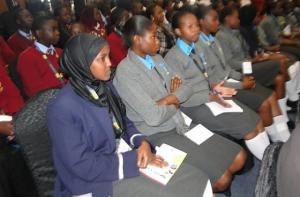Global ALL IN campaign fights rising HIV infections and deaths among adolescents
The Global ALL IN campaign against adolescent infection and death by HIV-AIDS kicked off with calls to listen, involve and include young people in efforts to reduce AIDS-related deaths and new HIV infections.
The launch presided by the Kenyan president Uhuru Kenyatta and lauded by various UN global leaders, is a fresh call to act on the rising numbers of infection and death among global and African youth. The campaign aims to achieve reductions in AIDS-related deaths by 65% and new HIV infection by 75% by 2020.
From statistics to real faces and voices, the manifestation of the human scourge painted a grim picture of a problem that needs urgent response and action. This includes:
AIDS is the leading cause of death in Africa and the second largest cause of death amongst adolescents globally;
16% of the 1.6 million people living with HIV/AIDS in Kenya are adolescents. 70% of infected adolescents are girls;
1 in every 5 aged 15-24 made their first sexual debut before age 15;
3 in 10 new infections in Kenya are among youth aged 15-24;
9720 adolescents and young people died of AIDS in 2012 in Kenya.
Speaking during the launch, several youth leaders and speakers called for effective programmes that involve and include the youth in order to address the issues they face more effectively. Youth leaders said most young people did not have access to information so they could make sound decisions and were more worried about getting pregnant or becoming a young parent than they were about getting infected with HIV/AIDS.
“Adults are not speaking to us or giving us guidance, yet we are as much risk as everyone else,” David Mutaha, an adolescent told the audience.
“I look at my friends and the lifestyle they are leading and I wonder what will happen to us,” he added.
Others painted the grim picture that children and youth living with HIV/AIDS face including being stigmatized at school and in the neighbourhoods. “Some of us do not know why we are taking the [antiretroviral] drugs,” Mercy Kilonzo said in reference to lack of information from parents and guardians.
Eleven-year-old Elijah Zachary stirred up a standing ovation when he passionately shared his story as an HIV survivor and the challenges he and many others face as peers, teachers and neighbours discriminate against them.
“HIV is not a death sentence and I know as long as I take my drugs, eat a good diet, my body will be fine,” he said.
“But I wonder how the other children are faring and if they have access to these drugs and a healthy diet like me,” he added.
He called on change of attitude and better treatment in the school system by teachers, curriculum and peers.
His appeal and that of other youth were met with positive commitment by the global leaders addressing the audience, including that of President Kenyatta.
The president lauded Elijah and colleagues for their courage and addressed the minister for health and education present to come up with a plan that would address the issues facing the youth with HIV/AIDS and prevention and treatment concerns.
“We now know the statistics and where these children are. Let us find them and support them with HIV medication [ARV’s],” he said.
He called for a review of the school curriculum to include HIV/AIDS lessons and how to support children living with HIV.
He also said dealing with youth vulnerabilities was critical given youth are the drivers of the economy in the future.
The WHO Director General whose message was aired to the meeting committed technical and practical support to the initiative.
She said health needs of youth rarely appeared in the traditional list of vulnerable groups and called for a participatory approach that would engage national youth alliances. She said data analysis was key to deeper understanding of the issues and added: “What gets measured, gets done.”
WHO Country Representative Dr Custodia Mandlhate called for a multisectoral approach and use of data to arrive at better decisions regarding young people and HIV/AIDS. She emphasized prevention, testing, and treatment.
“Measuring what we are doing is fundamental in order to make sound decisions,” she said.
Commitments to support the initiative also came from the US government through Ambassador Robert Codec, UNICEF, UNFPA Global Fund and UNAIDS and WHO.




